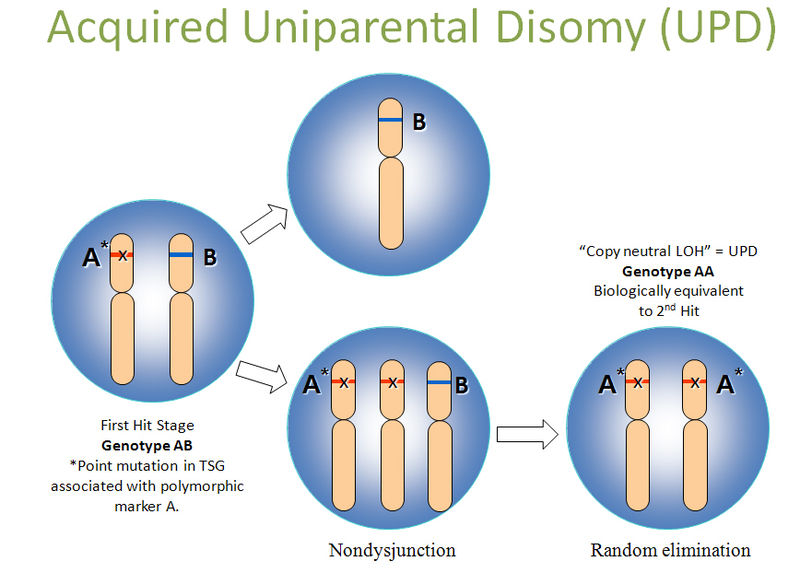The key difference between mosaicism and uniparental disomy is that mosaicism is the presence of a different genetic makeup in cells within the same person while uniparental disomy is the inheritance of two homologous chromosomes from the same parent.
Mosaicism and uniparental disomy are two genetic anomalies that arise from errors in meiosis and/or mitosis. They can occur independently or in combination. Therefore, chromosomal mosaicism can be associated with uniparental disomy. Chromosomal mosaicism is the presence of two or more chromosome complements within the same individual while uniparental disomy is the inheritance of two homologous chromosomes from a single parent.
CONTENTS
1. Overview and Key Difference
2. What is Mosaicism
3. What is Uniparental Disomy
4. Similarities Between Mosaicism and Uniparental Disomy
5. Side by Side Comparison – Mosaicism vs Uniparental Disomy in Tabular Form
6. Summary
What is Mosaicism?
Mosaicism or chromosomal mosaicism is the presence of two or more different chromosome complements within the same individual who developed from a single zygote. In simple words, mosaicism is the condition in which cells within the same person have a different genetic makeup. Mosaicism can be germline mosaicism or somatic mosaicism. Germline mosaicism occurs in gametes while somatic mosaicism occurs in somatic cells.
Mosaicism is associated with many different chromosomal abnormalities including trisomy, monosomy, triploidy, deletions, duplications, rings and other types of structural rearrangements. The most common mosaicism is mosaic aneuploidy. It arises due to meiotic events or from mitotic events. Down syndrome, Klinefelter syndrome and Turner syndrome are results of chromosomal mosaicism.
What is Uniparental Disomy?
Uniparental disomy is the phenomenon where an individual receives two copies of a chromosome. It may also refer to the phenomenon of receiving a part of the chromosome from one parent. Uniparental Disomy is a random occurrence that takes place during the development of gametes. The effect of uniparental disomy mainly relies on the inheritance and the expression of the particular genes. In some instances, uniparental disomy may affect the offspring. Therefore, it can either lead to the overexpression of a particular gene or the loss of function of the gene.

Figure 01: Uniparental Disomy
Uniparental disomy may lead to chromosomal aberrations and certain inheritance disorders. Some of them include Prader-Willi syndrome and Angelman Syndrome. Prader-Willi syndrome is associated with obesity and uncontrolled food intake, while Angelman syndrome leads to disability in intellectual characters and speech impairment. However, uniparental disomy may also lead to the onset of cancers and the expression of tumours. This is one of the most potent disadvantages of uniparental disomy.
What are the Similarities Between Mosaicism and Uniparental Disomy?
- Mosaicism and uniparental disomy are genetic abnormalities.
- Mosaic aneuploidy and uniparental disomy arise from mitotic or meiotic events.
- Chromosomal mosaicism can be associated with uniparental disomy.
- Both are responsible for many disease conditions.
What is the Difference Between Mosaicism and Uniparental Disomy?
Mosaicism is the presence of two or more karyotypically different cell lines within the same individual while uniparental disomy is the inheritance of two homologous chromosomes from a single parent. So, this is the key difference between mosaicism and uniparental disomy.
Moreover, another difference between mosaicism and uniparental disomy in terms of associated disease is that mosaicism is associated with Down syndrome, Klinefelter syndrome and Turner syndrome, etc., while uniparental disomy is associated with Prader-Willi syndrome and Angelman Syndrome.

Summary – Mosaicism vs Uniparental Disomy
Chromosomal mosaicism is the presence of numerous cell lines with different genetic makeups in the same individual. In contrast, uniparental disomy is the inheritance of two homologous chromosomes from the same parent. These two genetic abnormalities occur as a result of errors in meiosis or mitosis. Both are associated with different conditions. Thus, this summarizes the difference between mosaicism and uniparental disomy.
Reference:
1. Conlin, Laura K, et al. “Mechanisms of Mosaicism, Chimerism and Uniparental Disomy Identified by Single Nucleotide Polymorphism Array Analysis.” Human Molecular Genetics, Oxford University Press, 1 Apr. 2010, Available here.
2. “Mosaic (Genetics).” Wikipedia, Wikimedia Foundation, 12 Aug. 2020, Available here.
Image Courtesy:
1. “Copy neutral LOH” By Jhagenk (talk) – I created this work entirely by myself (CC BY 3.0) via Commons Wikimedia
ncG1vNJzZmivp6x7pbXFn5yrnZ6YsqOx07CcnqZemLyue8OinZ%2Bdopq7pLGMm5ytr5Wau265zqyYopuZqLpurc2dZK6mmaWus7HNrZilZZSewLC52Gg%3D